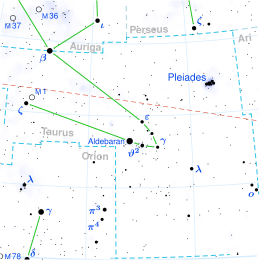Gamma Tauri
| Observation data Epoch J2000 Equinox J2000 | |
|---|---|
| Constellation | Taurus |
| Right ascension | 04h 19m 47.6037s[1] |
| Declination | +15° 37′ 39.512″[1] |
| Apparent magnitude (V) | 3.654[2] |
| Characteristics | |
| Spectral type | G8III[3] |
| U−B color index | +0.84[4] |
| B−V color index | +0.99[4] |
| Absolute magnitude (MV) | 0.22[3] |
| Details | |
Myr | |
| Database references | |
| SIMBAD | data |
Gamma Tauri (γ Tauri, abbreviated Gamma Tau, γ Tau) is either a solitary, binary or double star (the Washington Double Star Catalog notes it as a "Dubious Double" or "Bogus Binary"[12]) that marks the tip of the "V" in the constellation of Taurus. It is a member of, and located within about 2.5 parsecs of the center of, the Hyades star cluster, the nearest open cluster to the Sun. Based upon parallax measurements, Gamma Tauri is approximately 154 light-years from the Sun.
Considered as a pair of stars, the two components are designated Gamma Tauri A (officially named Prima Hyadum /ˌpraɪmə ˈhaɪədəm/, the traditional name for the system)[13] and B.
Nomenclature
γ Tauri (Latinised to Gamma Tauri) is the system's Bayer designation. The designations of the two potential components as Gamma Tauri A and B derive from the convention used by the Washington Multiplicity Catalog (WMC) for multiple star systems, and adopted by the International Astronomical Union (IAU).[14]
Gamma Tauri bore the traditional name Hyadum I,
In
Properties
Gamma Tauri presents as a spectral class G8 or K0[2][3] giant star with an apparent magnitude of +3.65. This star has passed through the main sequence phase is now a red clump giant, meaning it is using nuclear fusion of helium at its core to provide energy.[19] Age estimates for Gamma Tauri range from 430 million[3] to 530 million years.[6] By comparison, the age of the Hyades cluster is about 625 million years with an error margin of 50 million years.[6]
The
References
- ^ Bibcode:1997A&A...323L..49P
- ^ Centre de Données astronomiques de Strasbourg. Retrieved 2009-09-22.
- ^ S2CID 16258166.
- ^ doi:10.1086/145697.
- Bibcode:1967IAUS...30...57E.
- ^ S2CID 9341088.
- ^ S2CID 17092177.
- S2CID 16602121.
- ^
- ^ Bibcode:1970CoAsi.239....1B.
- ^ ISBN 0-486-21079-0.
- ^ "Washington Double Star Catalog". United States Naval Observatory. Archived from the original on 14 February 2011. Retrieved 2 January 2018.
- ^ a b "Naming Stars". IAU.org. Retrieved 16 December 2017.
- arXiv:1012.0707 [astro-ph.SR].
- ^ "IAU Working Group on Star Names (WGSN)". Retrieved 22 May 2016.
- ^ "WG Triennial Report (2015-2018) - Star Names" (PDF). p. 5. Retrieved 2018-07-14.
- ISBN 978-986-7332-25-7.
- ^ (in Chinese) 香港太空館 - 研究資源 - 亮星中英對照表 Archived 2008-10-25 at the Wayback Machine, Hong Kong Space Museum. Accessed on line November 23, 2010.
- S2CID 55224801.

